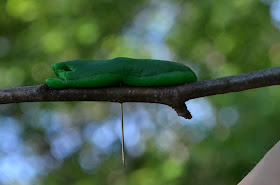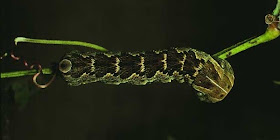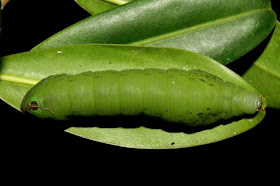For now, I'd just like to showcase this amazing caterpillar and Moss' description of its defensive behaviour (see below). These photos of Madoryx plutonius are again taken from the Janzen and Hallwachs database. The specimens were collected in Costa Rica as part of the ongoing inventory project within the Área de Conservación Guanacaste run by Dan Janzen and Winnie Hallwachs.
317. Madoryx pluto. (Plate 6.) [p. 394]
The larva in its final in star, if the championship among frauds be already won by the Leucorhawpha species [Moss is referring to H. triptolemus], nevertheless runs them closely, and takes a very high second place in the perfect success of those devices resorted to in first simulating the living stalk or stem of its food-plant, and then by endeavouring to terrorize one into the belief that one is gazing at an open-mouthed snake with red jaws and a couple of fierce, blue- black eyes' set immediately above them.
 |
| Final instar Madoryx plutonius caterpillar (at rest) Photo of specimen 95-SRNP-4624 from Janzen and Hallwachs database. |
 |
| Final instar Madoryx plutonius caterpillar (defensive posture) Photo of specimen 95-SRNP-4624 from Janzen and Hallwachs database. |
 |
| Final instar Madoryx plutonius caterpillar (defensive posture) Photo of specimen 95-SRNP-4624 from Janzen and Hallwachs database. |
This particular effect is produced entirely on the dorsal area by the larva lowering its head towards its legs, puffing out its thoracic segments (not laterally this time), and exhibiting these wonderfully brilliant touches of external ornament which at all other times when the caterpillar is sleeping or even when it is eating or in motion are entirely concealed within the interstices of its segments, and looks a perfect stick of a light brown coloration. Though I secured two photos, to take its portrait as a snake in pencil and paint was an exceedingly difficult task, for it would never maintain the attitude for a sufficient length of time, and soon got tired of even repeating the hoax for the edification of my much-impressed friends.
 |
| Final instar Madoryx plutonius caterpillar (at rest) Photo of specimen 95-SRNP-4624 from Janzen and Hallwachs database. |
 |
| Final instar Madoryx plutonius caterpillar (in defensive posture) Photo of specimen 95-SRNP-4624 from Janzen and Hallwachs database. |
 |
| Final instar Madoryx plutonius caterpillar (in defensive posture) Photo of specimen 95-SRNP-4624 from Janzen and Hallwachs database. |
 |
| Final instar Madoryx plutonius caterpillar (recovering to rest posture) Photo of specimen 95-SRNP-4624 from Janzen and Hallwachs database. |
Related posts:
- Moss' account of Hemeroplanes larvae in Para
- Possibly the best known eyespot caterpillar: Hemeroplanes sp. (Sphingidae)
References:
Kawahara, A. Y., Mignault, A.A., Regier, J.C., Kitching, I.J. and Mitter, C.M. (2009) Phylogeny and biogeography of hawkmoths (Lepidoptera: Sphingidae): evidence from five nuclear genes. PLoS ONE 4(5): e5719. doi:10.1371/journal.pone.0005719Moss AM. 1920. The Sphingidae of Para, Brazil. Novitates Zool. 27:333–424.





































